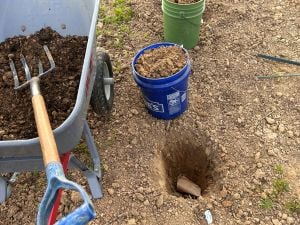I’m not sure why I first decided to create a planting recipe for tomatoes and other vegetables—maybe I just wanted to be consistent with my technique and work with what I already have. My goal is to use as much of my own resources as possible, like compost, bocking 14 tea, and other amendments, to stay consistent while also growing enough to feed four families and our church.
Over the past three years, I’ve bought many bags of planting soil that already had ingredients mixed in. But instead of relying on pre-made blends, I decided to start buying individual components—bone meal, fertilizer, lime, and even a truck bed full of leaf compost—just like making something from scratch. It’s often more cost-effective that way.
My soil has a lot of clay, but yours might need different amendments. This isn’t a one-recipe-fits-all approach—every garden is unique and with Bluebee (AI), designing your own soil mix becomes even easier! Here is my tomato recipe.
Equipment
I have basic equipment that I use for planting. You might come up with others.
- Shovel
- 5-gallon buckets (I use two per hole as I divide the soil as two smaller buckets are easier to dump in the wheelbarrow. Additional buckets to measure out compost and the half strength Miracle Grow water)
- Handheld hoe and cultivator to break up clay clumps
- several tablespoons
- 1/2 cup measure
- a quart container for watering
- brown paper like pieces of McDonald’s bags or brown grocery bags to wrap the fish in.
- Wheelbarrow for mixing

Soil Mixing & Planting Instructions
For Regular 12-Inch Holes (2-Foot-Tall Plants):
- Remove 4 gallons of soil from the hole and divide it into two buckets for easier handling.
- 1 gallon (16 cups) of composted leaf mulch.
- Homemade compost (if available): Replace up to 8 cups (1/2 gallon) of leaf mulch with compost for extra richness.
- 1–2 tablespoons of bone meal: Ensures immediate calcium and phosphorus availability.
- 1/4–1/2 cup of 8-24-24 fertilizer: Provides nitrogen, phosphorus, and potassium.
- 1–2 tablespoons of lime pellets: Helps break up clay soil, improving drainage and texture.
For Smaller 6–8-Inch Holes (8–12-Inch-Tall Plants):
- 2 gallons of removed soil.
- 1/2 gallon (8 cups) of composted leaf mulch.
- Homemade compost (if available): Replace up to 4 cups (1/4 gallon) of leaf mulch with compost.
- 1-tablespoons of bone meal.
- 1/8–1/4 cup of 8-24-24 fertilizer.
- 1-tablespoon of lime pellets.
Mid-Season Switch Hitters:
I recently planted the mid-June tomatoes, knowing rain was in the forecast—but the report called for just half an inch. Instead, the storm shifted, and my rain gauge showed 3.5 inches overnight! It turned into a mucky mess, and I lost about 10 tomatoes. Thankfully, I had backups ready, and I knew it was time for some mid-season switch hitters in my planting hole recipe.
This isn’t new—it seems like every rain turns into a gully-washer. April brought almost 15 inches in one weekend, May totaled nearly 9 inches, and now June is just as soggy. If this kind of weather is the new normal, I’ve got to rethink how I plant—especially in my clayish soil.
Mid-Season Adjustments:
Add 1 quart of coarse sand for 12-inch holes (or 2 cups for smaller holes)
Substitute Black Kow (½ gallon) when out of homemade compost (¼ gallon for smaller holes)
All other ingredients remain the same
My goal: Keep planting holes loose and drainable
Hole Size and Fish:
- For plants about 2 feet tall, dig a hole 12 inches deep. For smaller plants (8–12 inches tall), dig a hole 6–8 inches deep.
- If available, place fish parts at the bottom of the hole. I used a small whole brim fish. Wrap the fish in a small piece of a brown paper bag (e.g., a McDonald’s bag with soy-based or water-based ink, which is biodegradable and safe for gardening). Unprinted bags are also a great option. Brown paper bags help to reduce odors and deter pests.
- Cover the fish with a few inches of soil to prevent direct root contact until the fish decomposes.
Mixing:
- Mix thoroughly in the wheelbarrow to ensure even distribution of nutrients. Use the gallon markings on your bucket for accuracy, keeping solids like compost loosely packed while measuring.
Miracle-Gro Solution for Transplant Shock:
- Add 1/2 tablespoon of Miracle-Gro per gallon of water. Stir Thoroughly.
- Use this light solution to water the plants immediately after transplanting to reduce shock.
Planting the Tomatoes:
- Place the tomato plant in the prepared hole (adjust depth based on the plant size).
- Fill the hole with the blended soil mix, packing lightly around the roots to stabilize the plant.
- About halfway through filling the hole with soil, water the plant with the prepared Miracle-Gro solution. This helps settle the soil and gives the plant a healthy start. The amount will vary depending on soil moisture.
Additional Notes:
- Fast acting lime pellets are especially helpful for breaking up clay soil, improving texture and drainage while also balancing soil pH and adding calcium to prevent blossom end rot.
- Fish decomposes slowly, supplying nitrogen and phosphorus over time, while bone meal ensures immediate calcium and phosphorus availability. Bone meal is essential even if fish and fertilizer are used.
- Adjust proportions of soil amendments for smaller batches as outlined.
- If homemade compost is limited, prioritize using it for the first plants and combine it with leaf mulch to stretch your supply.
- This recipe will continue to evolve as needed—just like the weather!